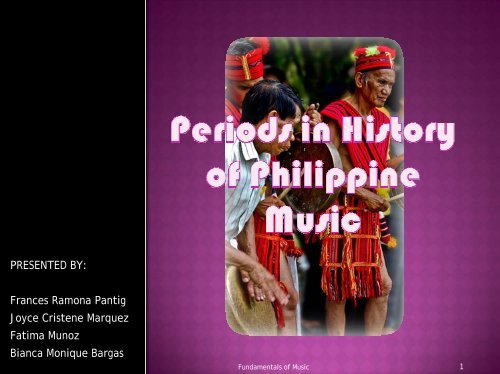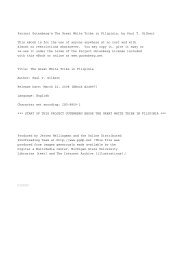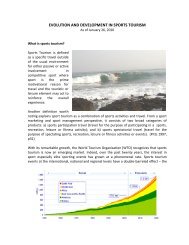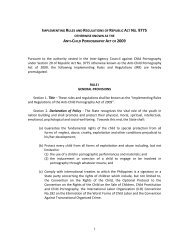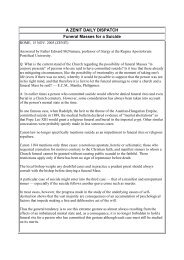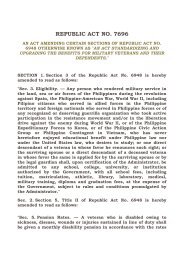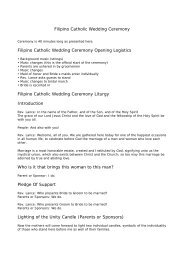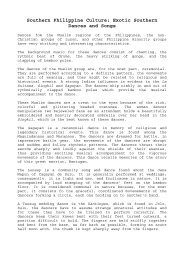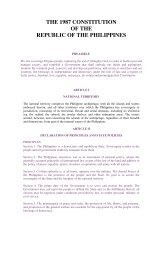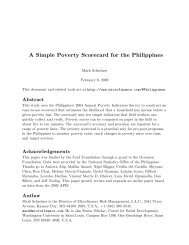History of Philippine Music - Philippine Culture: Overview Culture
History of Philippine Music - Philippine Culture: Overview Culture
History of Philippine Music - Philippine Culture: Overview Culture
Create successful ePaper yourself
Turn your PDF publications into a flip-book with our unique Google optimized e-Paper software.
PRESENTED BY:<br />
Frances Ramona Pantig<br />
Joyce Cristene Marquez<br />
Fatima Munoz<br />
Bianca Monique Bargas<br />
Fundamentals <strong>of</strong> <strong>Music</strong><br />
1
Fundamentals <strong>of</strong> <strong>Music</strong><br />
2
Filipinos are said to be <strong>Music</strong>al Peoples.<br />
In most cases, singing is accompanied by<br />
dancing.<br />
They used Bamboo canes, Palm leaves<br />
and bark <strong>of</strong> trees to write their songs and<br />
a piece <strong>of</strong> sharp stick or iron for their<br />
pen.<br />
Even their instruments were made <strong>of</strong><br />
Bamboo and wood which indicated their<br />
primitiveness.<br />
Fundamentals <strong>of</strong> <strong>Music</strong><br />
3
Functions <strong>of</strong> their music:<br />
• Religious<br />
• Social life<br />
Characteristics <strong>of</strong> their <strong>Music</strong>:<br />
• Recitative<br />
• Mostly simple two note music<br />
• Example <strong>of</strong> these are:<br />
Dal-lot – a song sung by farmers during wedding,<br />
baptismal and others parties accompanied by Kutibeng<br />
(guitar).<br />
Pamulinawen – is a love song<br />
Dung-aw – is a song requesting a dead person to be<br />
good in his next life.<br />
Fundamentals <strong>of</strong> <strong>Music</strong><br />
4
Early Filipinos music was influenced<br />
by trade relations other races like:<br />
Malays<br />
Indonesians<br />
Arabs<br />
Chinese<br />
Indo-Chinese<br />
Japanese and<br />
Hindus<br />
Fundamentals <strong>of</strong> <strong>Music</strong><br />
5
Chinese, Japanese and Hindus<br />
introduce their five-tone scale<br />
called pentatonic.<br />
The rhythmic effects through the<br />
use <strong>of</strong> gongs, drums and cymbals<br />
were brought by Hindus and<br />
Mohammedans.<br />
Reed type <strong>of</strong> wind instruments were<br />
brought by Japanese and Chinese<br />
Fundamentals <strong>of</strong> <strong>Music</strong><br />
6
• Ordinary songs (diyuna, talindaw)<br />
• Street songs (indulamin, suliranin)<br />
• Sorrow (dalit, umbay)<br />
• Wedding (ihiman)<br />
• Rowing (tigpasin, kalusan)<br />
• Lullaby (hele-hele, hili, oyayi, iyaya)<br />
• Success (baling-kungkong, dapayanin, hiliran,<br />
sambotani, tagumpay)<br />
• House (tingad)<br />
• General merry making (kalipay)<br />
• Counting (urukay)<br />
Fundamentals <strong>of</strong> <strong>Music</strong><br />
7
<strong>Music</strong>al Airs From different<br />
Regions<br />
Filipino <strong>Music</strong> has grown from<br />
the simple two note melody to<br />
the music that has become<br />
today.<br />
The following are the native<br />
music from different provinces<br />
in the <strong>Philippine</strong>s.<br />
Fundamentals <strong>of</strong> <strong>Music</strong><br />
8
Fundamentals <strong>of</strong> <strong>Music</strong> 9
Fundamentals <strong>of</strong> <strong>Music</strong><br />
10
Forms<br />
Their songs were more <strong>of</strong> recitative but the<br />
melody exudes customs, traditions and<br />
aspirations.<br />
Origins<br />
Most <strong>of</strong> the songs were adapted to<br />
other countries who traded with them,<br />
like:<br />
Malays<br />
Indonesians<br />
others<br />
Fundamentals <strong>of</strong> <strong>Music</strong><br />
11
Fundamentals <strong>of</strong> <strong>Music</strong> 12
CHARACTERISTICS<br />
More conservative style <strong>of</strong> sacred music.<br />
Minor key at the beginning shifts to a major<br />
key in the 2 nd -half Kundiman.<br />
Canto Ilocano, monophonic unmeasured style<br />
notated utilizing note shapes diferrent from<br />
the neumes <strong>of</strong> Gregorian chant (composition<br />
<strong>of</strong> the Kirial).<br />
Canto de Oregano, simple polyphonic settings<br />
in to two or more vocal portraying.<br />
Religiosity and <strong>Music</strong>ality – salvation <strong>of</strong> selfexpression<br />
Fundamentals <strong>of</strong> <strong>Music</strong><br />
13
Sacred <strong>Music</strong><br />
• Figured Chant <strong>Music</strong><br />
• Measured Plainsong<br />
• 1795 (Golden Age <strong>of</strong> Sacred <strong>Music</strong>)<br />
• Passion Song<br />
Other <strong>Music</strong>al Forms<br />
Songs<br />
• Harana<br />
Fundamentals <strong>of</strong> <strong>Music</strong><br />
14
<strong>Music</strong><br />
•as a fine art<br />
•as a subject to be taught<br />
Fundamentals <strong>of</strong> <strong>Music</strong><br />
15
Spanish Period<br />
Fundamentals <strong>of</strong> <strong>Music</strong> 16
1.Tagulaylay: counterpart <strong>of</strong><br />
“lamentation”<br />
2. Palimos: song for begging<br />
Fundamentals <strong>of</strong> <strong>Music</strong><br />
17
3.Kumintang: originated in Balyan,<br />
Batangas<br />
a. Kumintang <strong>of</strong> the conquest<br />
b. Kumintang <strong>of</strong> the Balayan<br />
c. Kumintang with which the Awits are accompanied<br />
Examples:<br />
“La Tagala” -- Jose Estella<br />
“Amihan” -- Antonio Molina<br />
“Auras de Terruno” -- Juan S. Hernandez<br />
“Pagdilidli” -- Lucino Sacramento<br />
Fundamentals <strong>of</strong> <strong>Music</strong><br />
18
4. Awit<br />
Examples:<br />
“Awit” -- F. Santiago<br />
“Ang Ulila” -- Antonio Molina<br />
“Batingaw na Pilak” -- Antonio Molina<br />
“Recuerdo de Filipinas y Sus cantares”--Diego<br />
Perez<br />
Fundamentals <strong>of</strong> <strong>Music</strong><br />
19
5. Balitaw<br />
• Balitaw Mayor<br />
Visayan Balitaw<br />
Tagalog Balitaw<br />
Dansa Menor<br />
Examples:<br />
1. “Hating-gabi” -- Antonio Molina<br />
2. “Sampaguita” -- Dalores Paterno<br />
3. “Ay, Ay, Kalisud” -- Visayan Folksong<br />
6. Kundiman: came from the words “king hindi<br />
man”<br />
Fundamentals <strong>of</strong> <strong>Music</strong><br />
20
Fundamentals <strong>of</strong> <strong>Music</strong> 21
There are 175 folk dances in the<br />
<strong>Philippine</strong>s in which Jose Rizal<br />
was all praise for these.<br />
Filipinos enjoyed European<br />
dances like the: (next slides)<br />
Fundamentals <strong>of</strong> <strong>Music</strong><br />
22
LA CUCARACHA<br />
Fundamentals <strong>of</strong> <strong>Music</strong><br />
23
FANDANGO<br />
Fundamentals <strong>of</strong> <strong>Music</strong><br />
24
SAPATAEDO<br />
Fundamentals <strong>of</strong> <strong>Music</strong><br />
25
TANGO<br />
Fundamentals <strong>of</strong> <strong>Music</strong><br />
26
RIGODON<br />
Fundamentals <strong>of</strong> <strong>Music</strong><br />
27
Fundamentals <strong>of</strong> <strong>Music</strong> 28
Best exports <strong>of</strong> the <strong>Philippine</strong>s<br />
and propagandize <strong>of</strong> the<br />
country’s vast reservoir <strong>of</strong><br />
inalienable heritage:<br />
•Bayanihan Dance Troupe<br />
•Barangay Dance Troupe<br />
Fundamentals <strong>of</strong> <strong>Music</strong><br />
29
Well known<br />
choreographer <strong>of</strong> the<br />
world famous<br />
Bayanihan Dance<br />
troupe who said that<br />
<strong>Philippine</strong> indigenous<br />
music can be divided<br />
into 3 distinct groups:<br />
(featured in next<br />
slides)<br />
Fundamentals <strong>of</strong> <strong>Music</strong><br />
30
Fundamentals <strong>of</strong> <strong>Music</strong><br />
31
A string band<br />
consisting <strong>of</strong><br />
plucked<br />
instruments as the<br />
guitar, banduria,<br />
octavina, laud, and<br />
banjo.<br />
Fundamentals <strong>of</strong> <strong>Music</strong><br />
32
Fundamentals <strong>of</strong> <strong>Music</strong><br />
33
GANSA<br />
KULINTANG<br />
Fundamentals <strong>of</strong> <strong>Music</strong><br />
34
Bamboo Flute<br />
Gong<br />
Fundamentals <strong>of</strong> <strong>Music</strong><br />
35
Fundamentals <strong>of</strong> <strong>Music</strong><br />
36
Tondo Theatre – was erected mainly to<br />
stage Tagalog plays in 1841. Spanish dramas<br />
were acted also there.<br />
Teatro Castellano – better known as Teatro<br />
de Binondo was built by Engineer Jose Bosch<br />
for Manuel Ponce de Leon <strong>of</strong> where a variety<br />
<strong>of</strong> songs and plays are exhibited.<br />
Teatro Comico in Manila –Wenceslao<br />
Retana y Gamboa mentioned the existence<br />
<strong>of</strong> these theatre in 1790.<br />
Fundamentals <strong>of</strong> <strong>Music</strong><br />
37
Arroceros Theatre - near the Mehan<br />
garden presented Tagalog plays according<br />
to Juan Atayde.<br />
Casino in Intramuros – here, evening<br />
parits were held by social gatherings<br />
particularly the Recreational Society.<br />
Fundamentals <strong>of</strong> <strong>Music</strong><br />
38
Fundamentals <strong>of</strong> <strong>Music</strong><br />
39
PASSION PLAYS<br />
Fundamentals <strong>of</strong> <strong>Music</strong><br />
40
Performances were held in vacant lots or<br />
fields.<br />
During celebrations such as town fiestas,<br />
performers used provisional stage <strong>of</strong> nipa<br />
and bamboo.<br />
Later, theatre bodegas, as those seen<br />
over cockpits appeared.<br />
Fundamentals <strong>of</strong> <strong>Music</strong><br />
41
In 1841, Tondo Theatre was erected mainly to<br />
stage tagalog plays.<br />
Teatro Castellano or Teatro de Binondo was<br />
built by Jose Bosch.<br />
In 1790, Teatro Comico de Manila was<br />
mentioned by Wenceslao Retana Y Gamboa<br />
Social gatherings were held at the Casino in<br />
Intramuros by the Sociedad de Recreo. There<br />
were dancing, singing and instrumental<br />
performances.<br />
Fundamentals <strong>of</strong> <strong>Music</strong><br />
42
Fundamentals <strong>of</strong> <strong>Music</strong><br />
43
Moro moro<br />
-depicts the battle between the Christians and Muslims and<br />
the adaptations <strong>of</strong> the legends about knight-errant’s and<br />
princesses.<br />
Fundamentals <strong>of</strong> <strong>Music</strong><br />
44
Carillo<br />
is a shadow play using puppets made from cardboard.<br />
The themes were derived from the libretto from “Don<br />
Quixote”, “Buhay ng Mahal ng Panginong Hesukristo”<br />
Fundamentals <strong>of</strong> <strong>Music</strong><br />
45
Zarzuela<br />
Piece <strong>of</strong> entertainment with improvised plots that used in<br />
comic, tragic, fantastic,, melodramatic or a combination <strong>of</strong> all.<br />
Later, these “Fiestas de Zarzuelas” were simply called Zarzuela that<br />
involves singing and dancing in it. It has no definite form. Singing<br />
was free and imaginative. Audience swapped comments with the<br />
artists called Piscatory Eclogue.<br />
Fundamentals <strong>of</strong> <strong>Music</strong><br />
46
Piscatory Eclogue is preceded by loa and<br />
mojiganga.<br />
Loa<br />
• is a prologue, spoken by two <strong>of</strong> more actors.<br />
Mojiganga<br />
-a popular festival and carnival time, a sort<br />
<strong>of</strong> burlesque masquerade accompanied by<br />
flute, castanets and side drums.<br />
After middle <strong>of</strong> the 17 th century the<br />
mojiganga was replaced by the “Fin de<br />
fiesta”.<br />
The best zarzuelistas are from Pampanga<br />
Fundamentals <strong>of</strong> <strong>Music</strong><br />
47
Fundamentals <strong>of</strong> <strong>Music</strong> 48
The American Educational System<br />
have greatly influenced the<br />
<strong>Philippine</strong> system <strong>of</strong> music education<br />
with the treatment <strong>of</strong> music as a<br />
part <strong>of</strong> broad pattern <strong>of</strong> liberal<br />
education.<br />
With the establishments <strong>of</strong><br />
conservatories (schools for special<br />
instruction in music), formal<br />
education in music started.<br />
Fundamentals <strong>of</strong> <strong>Music</strong><br />
49
Fundamentals <strong>of</strong> <strong>Music</strong><br />
50
<strong>Philippine</strong> Opera evolved from the<br />
Zarzuela.<br />
Zarzuela was based on the European<br />
metrical tales and set to the familiar<br />
Spanish tunes which easily gained<br />
approval among the traditionally<br />
theater loving Filipinos.<br />
All Zarzuelas are nationalistic in<br />
nature<br />
Fundamentals <strong>of</strong> <strong>Music</strong><br />
51
Examples <strong>of</strong> Zarzuelas:<br />
• Minda Mora (Minda, the Moro Girl) – Juan<br />
Hernandez<br />
• Pa-ibig sa Tinubuang Lupa (Love <strong>of</strong><br />
Country) – Pascual Poblete<br />
• Tanikalang Guinto (Chain <strong>of</strong> Gold) – Juan<br />
Abad<br />
• Walang Sugat (No Wound) – Severino<br />
Reyes<br />
Fundamentals <strong>of</strong> <strong>Music</strong><br />
52
American singing trough jazz invaded the<br />
country<br />
Most <strong>of</strong> the songs are nationalistic in nature<br />
Instrumental music and vocal music are both<br />
important in this period<br />
Non-commercial<br />
<strong>Music</strong>al Form(s):<br />
• Symphony<br />
• Opera<br />
Opera Buffa<br />
Fundamentals <strong>of</strong> <strong>Music</strong><br />
53
Fundamentals <strong>of</strong> <strong>Music</strong> 54
Their desire to propagate<br />
nipongo as the common<br />
language was a dismal<br />
failure.<br />
This was the darkest period<br />
in the history <strong>of</strong> the<br />
<strong>Philippine</strong>s.<br />
Fundamentals <strong>of</strong> <strong>Music</strong><br />
55
Pentatonic<br />
Employs the universal material <strong>of</strong> sound organized by<br />
rhythm, melody and tone quality<br />
Monophonic<br />
Sentimental and religious<br />
uplifting, driving, and rollicking<br />
emotional, poetic, or even somber<br />
emotional, poetic, or even somber<br />
The rhythms are based on ma; silence is important<br />
The tempo usually starts out very slow and gets faster, returns to<br />
being slow again, and has a drawn-out ending<br />
FORMS<br />
• <strong>Music</strong>al March<br />
• Symphony<br />
• Orchestra<br />
Fundamentals <strong>of</strong> <strong>Music</strong><br />
56
Fundamentals <strong>of</strong> <strong>Music</strong><br />
57
The reawakening <strong>of</strong> interest in diverse forms<br />
<strong>of</strong> culture is manifested in the proliferation<br />
<strong>of</strong> ensembles, vocal and instrumental not<br />
only in schools but also in churches,<br />
government and private <strong>of</strong>fices,<br />
communities and within the family.<br />
Need for pr<strong>of</strong>essional growth is evident in<br />
holding <strong>of</strong> in-service-training programs,<br />
seminars, workshops, and conferences<br />
sponsored by schools, government agencies<br />
and musical organizations such as the<br />
<strong>Philippine</strong> Society for <strong>Music</strong> Education, and<br />
the <strong>Philippine</strong> National Society for music<br />
Education.<br />
Fundamentals <strong>of</strong> <strong>Music</strong><br />
58
Vocal and instrumental music are both important<br />
Emotional and creative<br />
Songs <strong>of</strong> nobility and nationalism were common<br />
in that period<br />
The use <strong>of</strong> found sounds, recorded voices, the<br />
shift from increasingly chromatic surfaces to<br />
more triadic ones or the reverse, the use <strong>of</strong> new<br />
instrumental combinations<br />
FORMS:<br />
• Symphony<br />
• Orchestra<br />
• Sacred/Religious<br />
Instrumental soloist<br />
Fundamentals <strong>of</strong> <strong>Music</strong><br />
59
Fundamentals <strong>of</strong> <strong>Music</strong><br />
60
A. Nationalism in <strong>Music</strong><br />
B. Passage <strong>of</strong> R.A. 4723<br />
C. Formation <strong>of</strong> <strong>Music</strong> Organizations<br />
A. The <strong>Music</strong> promotion Foundation was created<br />
B. The <strong>Philippine</strong> Theater <strong>of</strong> Performing Arts<br />
produces operas and musicals.<br />
D. Use <strong>of</strong> Educational Television<br />
Fundamentals <strong>of</strong> <strong>Music</strong><br />
61
Fundamentals <strong>of</strong> <strong>Music</strong><br />
62
Original Pilipino <strong>Music</strong>, now more commonly termed<br />
Original Pinoy <strong>Music</strong> or Original <strong>Philippine</strong> <strong>Music</strong>,<br />
(frequently abbreviated to OPM) originally referred only<br />
to <strong>Philippine</strong> pop songs, especially those in the ballad<br />
form.<br />
Having successfully created a subgenre <strong>of</strong> <strong>Philippine</strong> Rock<br />
they called Bisrock, the Visayans by far have the biggest<br />
collection <strong>of</strong> modern music in their native language<br />
Inspired by what the locals call "Kapampangan cultural<br />
renaissance," Angeles City-born balladeer Ronnie Liang<br />
rendered Kapampangan translations <strong>of</strong> some <strong>of</strong> his<br />
popular songs such as "Ayli" (Kapampangan version <strong>of</strong><br />
"Ngiti"), and "Ika" (Kapampangan version <strong>of</strong> "Ikaw") for his<br />
repackaged album..<br />
Fundamentals <strong>of</strong> <strong>Music</strong><br />
63
1. Christmas in Our Hearts 1990 Jose Mari Chan (20x Platinum)<br />
2. Constant Change 1989 Jose Mari Chan (10x Platinum)<br />
3. Cutterpillow 1995 Eraserheads (10x Platinum)<br />
4. Nina Live! 2005 Nina (8x Platinum)<br />
5. Forevermore EP 1995 Side A (8x Platinum)<br />
6. Paraiso 1991 Smokey Mountain (8x Platinum)<br />
7. Smokey Mountain 1989 Smokey Mountain (8x Platinum)<br />
8. Halik 2000 Aegis (7x Platinum)<br />
9. Ten Years Together 1980 APO Hiking Society (7x Platinum)<br />
10. 10 Habang May Buhay 1995 Donna Cruz (7x Platinum)<br />
Fundamentals <strong>of</strong> <strong>Music</strong><br />
64
Fundamentals <strong>of</strong> <strong>Music</strong> 65
Juan Dela Cruz Band, a Garage Rock- and Blues<br />
Rock-influenced group consisting <strong>of</strong> guitarist<br />
Wally Gonzalez, bassist Mike Hanopol, and<br />
drummer Pepe Smith, are <strong>of</strong>ten credited for<br />
ushering in the first "rock & roll revolution" in<br />
the <strong>Philippine</strong>s that lasted from the late '60s to<br />
the late '70s (also known as the Golden Age <strong>of</strong><br />
Pinoy Rock). Considered by many to be the<br />
"grandfathers" <strong>of</strong> Pinoy Rock<br />
The most notable achievement in <strong>Philippine</strong> rock<br />
<strong>of</strong> the 1960s was the hit song "Killer Joe," which<br />
propelled the group "Rocky Fellers" which<br />
reached number 16 on the American radio<br />
charts.<br />
Fundamentals <strong>of</strong> <strong>Music</strong><br />
66
Pepe Smith<br />
Wally Gonzales<br />
Mike Hanopol<br />
Fundamentals <strong>of</strong> <strong>Music</strong><br />
67
Folk-rock became the <strong>Philippine</strong> protest<br />
music <strong>of</strong> the 1980s, and Aguilar's "Bayan<br />
Ko" (My Country) became popular as an<br />
anthem during the 1986 EDSA Revolution.<br />
At the same time, a counterculture<br />
rejected the rise <strong>of</strong> politically focused<br />
lyrics<br />
1990s saw the emergence <strong>of</strong> a superstar<br />
pop-rock group, the Eraserheads,<br />
considered by many <strong>Philippine</strong> nationals<br />
as the number one group in the <strong>Philippine</strong><br />
recording scene.<br />
Fundamentals <strong>of</strong> <strong>Music</strong><br />
68
<strong>Philippine</strong> rock musicians added folk music, and<br />
other influences<br />
Pop-rock groups became more popular among<br />
teens<br />
The Neo-Traditional genre in <strong>Philippine</strong> music is<br />
also gaining popularity<br />
Vocal music is more important than instrumental<br />
music<br />
An aim <strong>of</strong> appealing to a general audience,<br />
rather than to a particular sub-culture or<br />
ideology<br />
An emphasis on recording, production, and<br />
technology, over live performance<br />
Fundamentals <strong>of</strong> <strong>Music</strong><br />
69
Fundamentals <strong>of</strong> <strong>Music</strong><br />
70


